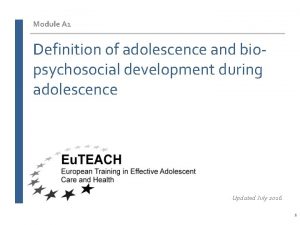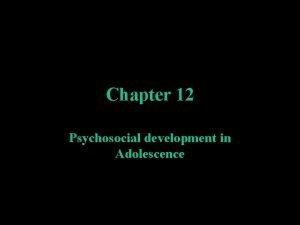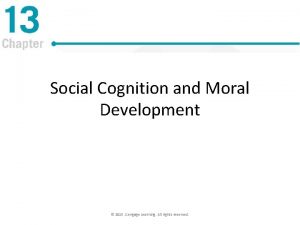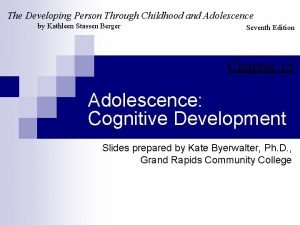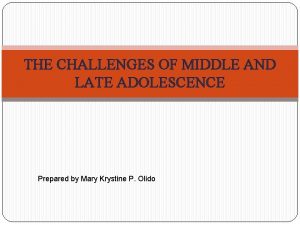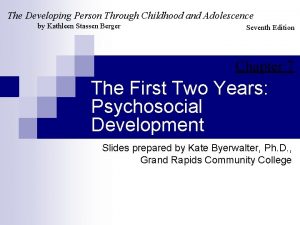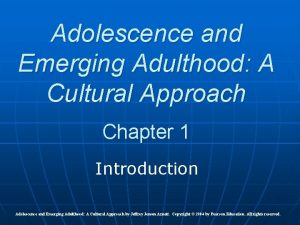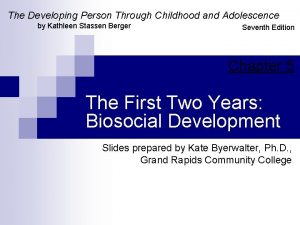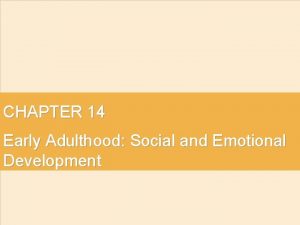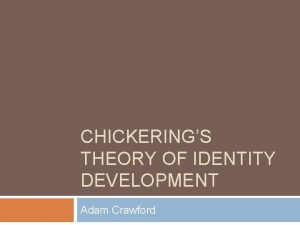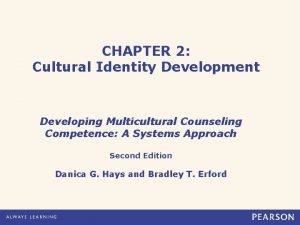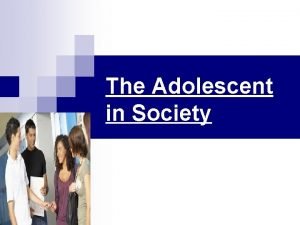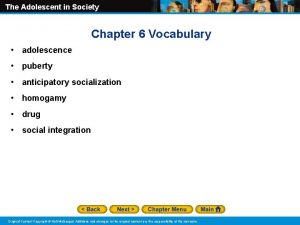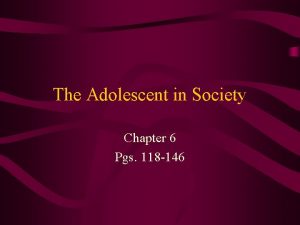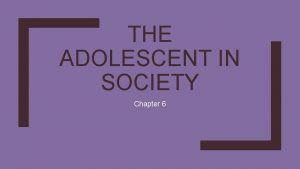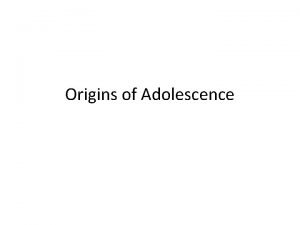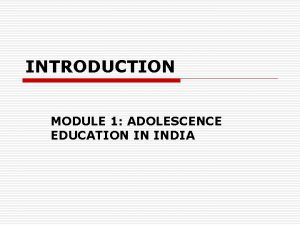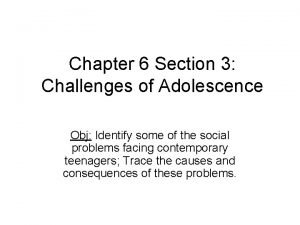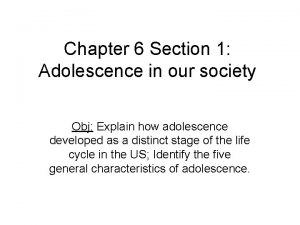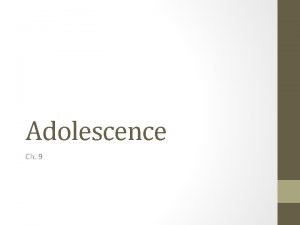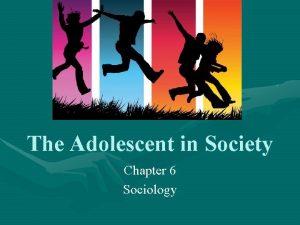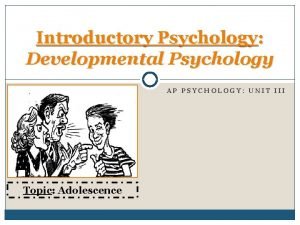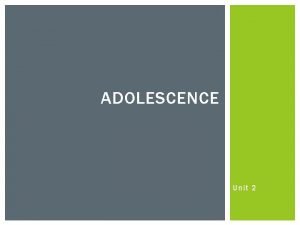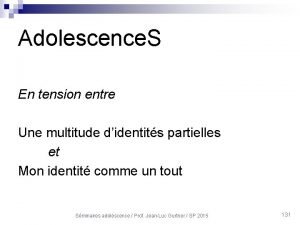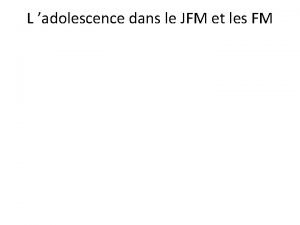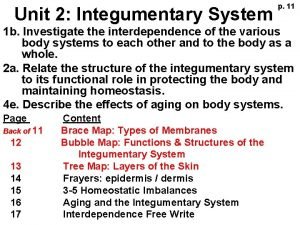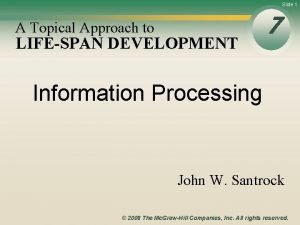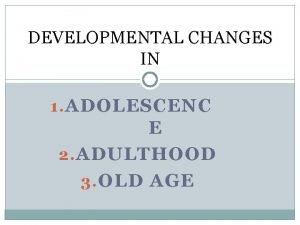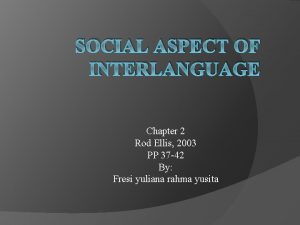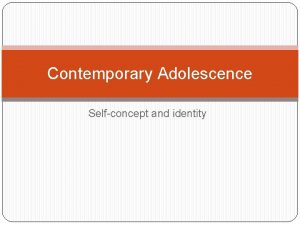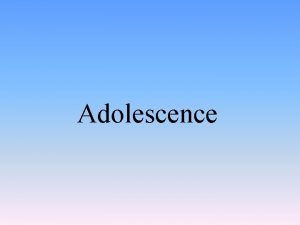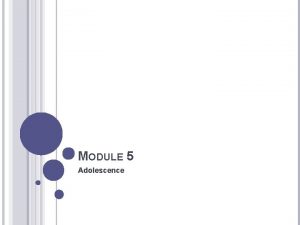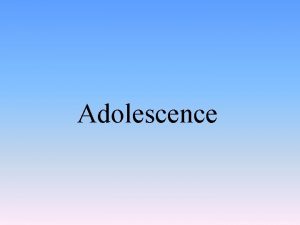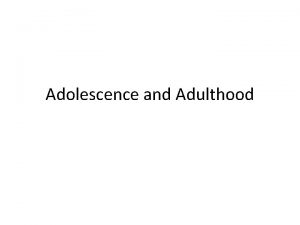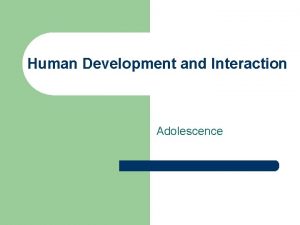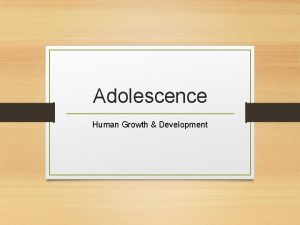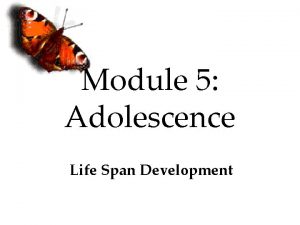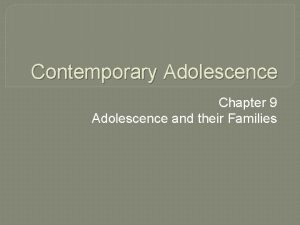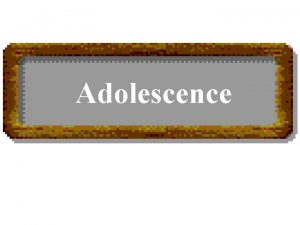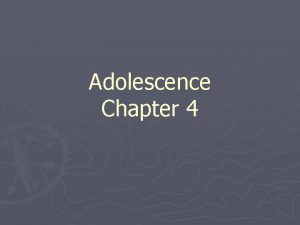Identity Identity development and adolescence Selfconceptions during adolescence
























































- Slides: 56

Identity • • Identity development and adolescence Self-conceptions during adolescence Self-esteem change during adolescence Adolescent identity – Ethnic identity – Gender identity

Identity: Why an Adolescent Issue? • Changes in the way we see and feel about ourselves occur throughout the life span • Adolescence marks the first restructuring of one’s sense of self at a time when he or she can appreciate the significance of these changes

Identity: Why an Adolescent Issue? • Physical changes of puberty – Appearance – Relationships with others • Cognitive changes – Imagine possible selves – Develop a future orientation • Social changes – In self-conceptions – In self-esteem – In sense of identity

Changes in Self-Conceptions • Self-conception is the way individuals think about and characterize themselves (traits and attributes) • During adolescence, more complex, abstract selfconceptions develop • Personality is expressed in different ways in different situations • Differentiated self-concept: – Actual self – Ideal self – Feared self

Childhood vs. Adolescence I have a dog named Jake and a brother named Silas. I’m good at sports, but not so good at school. Concrete terms, related to traits I’m complicated. I’m sensitive, outgoing, popular and tolerant. I can be shy in some circumstances. I can also be self-conscious, even obnoxious when I’m upset…. I have a positive view of humankind…. Trait-focused, traits more abstract, personality characteristics

More Complex Sense of Self The formal operational ability to perceive multiple aspects of a situation or idea mean that selfunderstanding becomes more complex in adolescence. I recognize contradictions in my personality…. Which is the REAL me? ? ? I’m shy around my relatives, but outgoing with my friends…. I’m aware that I sometimes show a FALSE self to others that isn’t really the me or the way I think and feel

The multiple selves of a 15 -year-old girl

Changes in Self-Conceptions • False-Self Behavior – Acting in a way that one knows in inauthentic or fake – Most likely to happen in dating situations – Least likely to happen around close friends

Personality in Adolescence • The Five-Factor Model of Personality (The “Big Five”): – – – Extraversion (outgoing and energetic) Agreeableness (kind or sympathetic) Conscientiousness (responsibility) Neuroticism (anxious or tense) Openness to Experience (curiosity)

Personality in Adolescence • “Big Five” personality traits – Influenced by combination of genetic and environmental factors – Strong links between earlier infant temperament and adolescent personality • Adolescence is not a time of rebirth in terms of personality – Most personality traits are quite stable during adolescence

Changes in Self-Esteem • Self-esteem – How an individual feels about him or herself • Self-esteem is fairly stable over time – Baseline self-esteem: The way that adolescents typically feel about themselves overall (e. g. , “I am a good person”) • Adolescents’ feelings about themselves fluctuate day by day – Barometric self-esteem: The way that adolescents feel about themselves depending on specific events of that day (e. g. , “I feel bad that I was mean to my friend”)

Self-esteem: Defining Aspects • Baseline Self-esteem – Stable, enduring sense of worth and wellbeing • Barometric Self-esteem – Fluctuating sense of worth and well-being as one responds to different thoughts, experiences, etc. through the course of a day

Adolescent Self-image: 8 Domains Susan Harter (1989… 2001) • • Scholastic Competence Social Acceptance Athletic Competence Physical Appearance Job Competence Romantic Appeal Behavioral Conduct Close Friendship

The Relative Importance of Different Sources of Self-Esteem Susan Harter (1989… 2001) An Example Peers Global Self-Esteem School Family Body Image Sports/ Athletics

Changes in Self-Esteem • During early adolescence – Increased volatility in barometric self-image – Different trajectories for different adolescents • Young adolescents with the most volatile barometric selfesteem report the highest levels of anxiety, tension, psychosomatic symptoms, and irritability

Experience Sampling Method • “Beeper” studies in which adolescents are beeped at random times during the day and asked to record their emotional state • Adolescents record feeling “self-conscious” and “embarrassed” 2 -3 times more than adults • Adolescents are “moodier” than preadolescents • Adolescents experience more negative moods than preadolescents • Older adolescents were less volatile (fewer extremes) in emotions than younger adolescents

Decline in Average Emotional States (Larson et al, 2002) Average emotional states decline from grade 5 through 11 and then appear to level off at grade 12 Consistently higher numbers for girls than for boys

Self-Esteem and Transitions

Self-esteem in Emerging Adulthood For most young people, self-esteem rises during emerging adulthood. Why might this be?

Sex Differences in Self-Esteem

Sex Differences in Self-Esteem Negative Evaluations of Appearance Among Adolescents Who Rank These Characteristics High for Self-Esteem

Sex Differences in Self-Esteem Negative Evaluations of Weight Among Adolescents Who Rank These Characteristics High for Self-Esteem

Sex Differences in Self-Esteem • Gender differences in self-esteem (boys > girls) – become smaller over course of adolescence – more pronounced among white and Puerto Rican teens – less pronounced among African-American teens • Middle-class > lower SES – have higher self-esteem than their less-affluent peers – SES discrepancy grows larger over the course of adolescence • African-American girls > white/Hispanic – Do not feel as negative about appearance – Have higher overall self-esteem – Show less of a decline in self-esteem over adolescence

Racial Differences in Self-Esteem African American (Self-Esteem Highest) White Adolescents Hispanic American Asian American Native American

Racial Differences in Self-Esteem • Higher self-esteem among African-American teens – Benefit from support/positive feedback of adults in the African-American community, especially in the family – Focus on areas of strength, not weakness – Have a strong sense of ethnic identity that enhances self-esteem

Ethnic Differences in Self-Esteem • Lower self-esteem among Hispanic-American teens – Lower levels of authoritative parenting – Lower levels of perceived teacher support – Weaker sense of ethnic identity – Higher levels of family stress

Antecedents and Consequences of High Self-Esteem • Across all demographic groups, self-esteem is related to: – Parental approval – Peer support – Success in school • Teens who derive self-esteem from peers, rather than teachers or parents, show more behavioral problems and poorer school achievement

The Adolescent Identity Crisis • Erikson’s Theoretical Framework The establishment of a coherent sense of identity is the chief psychosocial crisis of adolescence

The Adolescent Identity Crisis

Identity “Crisis” in Adolescence Crisis = “Exploration” Identity Achievement Establishing a clear and definite sense of who you are and how you fit into the world around you. vs. Identity Confusion Failure to form a stable and secure identity. Keep in Mind… Achieving identity requires exploration – sifting through life choices, trying out possibilities, and ultimately making commitments.

Items from the Objective Measure of Ego Identity Status 1. I haven’t chosen the occupation I really want to get into, and I’m just working at what is available until something better comes along. 2. When it comes to religion I just haven’t found anything that appeals and I don’t really feel the need to look. 3. My ideas about men’s and women’s roles are identical to my parents’. What has worked for them will obviously work for me. 4. There’s no single “life style” which appeals to me more than another. 5. There a lot of different kinds of people. I’m still exploring the many possibilities to find the right kind of friends for me. 6. I sometimes join in recreational activities when asked, but I rarely try anything on my own. … 63. I date only people my parents would approve of. 64. My folks have always had their own political and moral beliefs about issues like abortion and mercy killing and I’ve always gone along accepting what they have. For more information, see www. uoguelph. ca/%7 Egadams/omeis. htm

Four Identity Statuses: Examples Identity Status Character from TV, Movie, or Book Diffusion ? Moratorium ? Foreclosure ? Achievement ?

Four Identity Statuses: Examples Identity Status Diffusion Example “I’m not worried about what to do after school…who cares. ” Moratorium “I want to be a marine biologist, no… a lawyer, no…a hairdresser like my best friends’ mom. ” Foreclosure “I never had to think about what to do, I’m taking over the farm from Dad. ” Achievement “After studying in Peru, I realize I cannot work for a large corporation, I am going to be a nurse. ”

The Adolescent Identity Crisis: Identity versus Identity Diffusion • The adolescent’s identity results from a mutual recognition between the young person and society • The adolescent forges an identity, but at the same time society identifies the adolescent • Key to resolution lies in social interactions (according to Erikson)

The Social Context of Identity Development • Course of identity development varies by culture and historical era – Many more career options for women than in the past means more complicated choices to make • The more alternatives that are available, the more difficult it is to establish a sense of identity • Because of these complications, adolescents may need a “time out” to figure out identity before entering adult roles

The Social Context of Identity Development Psychological Moratorium • “Time out” from excessive responsibilities and obligations • Experiment with different roles • Luxury of the affluent if introspection interferes with survival

Problems in Identity Development • Identity diffusion – incoherent, disjointed, incomplete sense of self • Identity Foreclosure – bypassing the period of exploration and experimentation • Negative Identity – identities that are undesirable to parents or the community

Identity Development • Determining an Adolescent’s Identity Status – Degree of commitment – Degree of exploration or crisis

Identity Development • Identity generally not established before age 18 • During college, vocational plans solidify – but not religious and political beliefs • College may prolong psychosocial moratorium – especially for political and religious beliefs • Individuals may move from one identity status to another, particularly during adolescent and young adult years

Occupation Choice & Identity Status A = Achievement M= Moratorium F= Foreclosure D= Diffusion

Occupation Choice & Identity Status A = Achievement M= Moratorium F= Foreclosure D= Diffusion

Occupation Choice & Identity Status A = Achievement M= Moratorium F= Foreclosure D= Diffusion

Occupation Choice & Identity Status A = Achievement M= Moratorium F= Foreclosure D= Diffusion

Occupation Choice & Identity Status A = Achievement M= Moratorium F= Foreclosure D= Diffusion

Occupation Choice & Identity Status A = Achievement M= Moratorium F= Foreclosure D= Diffusion

Gender and Identity I’ll put my plans to explore Consider this scenario in terms careers of gender and identity different on hold formation in adolescence and emerging adulthood… because it’s important that I maintain my relationship. My fiancé is planning to study engineering, and I’ll move to Chicago with him to support his studies… Young women tend to have more difficulty than young men in integrating their aspirations for love with their aspirations for work, in part because of gender double standards. Identity formation conflicts with the task of young adults to achieve intimacy vs. isolation.

Masculine Characteristics Feminine Characteristics Independent Emotional Aggressive Grateful Acts as leader Kind Self-confident Creative Dominant Gentle Active Understanding Ambitious Aware of others' feelings Outspoken Enjoys art and music Adventurous Tactful Competitive Considerate Likes math and science Home oriented Takes a stand Cries Easily Makes decisions easily Devotes self to others Skilled in business Strong conscience

The Bem Sex-Role Inventory 1. self reliant 2. yielding 3. helpful 4. defends own beliefs 5. cheerful 6. moody 7. independent 8. shy 9. conscientious 10. athletic 11. affectionate 12. theatrical 13. assertive 14. flatterable 15. happy 16. strong personality 17. loyal 18. unpredictable 19. forceful 20. feminine 21. reliable 22. analytical 23. sympathetic 24. jealous 25. leadership ability 26. sensitive to other's needs 27. truthful 28. willing to take risks 29. understanding 30. secretive 31. makes decisions easily 32. compassionate 33. sincere 34. self-sufficient 35. eager to soothe hurt feelings 36. conceited 37. dominant 38. soft spoken 39. likable 40. masculine 41. warm 42. solemn 43. willing to take a stand 44. tender 45. friendly 46. aggressive 47. gullible 48. inefficient 49. acts as a leader 50. childlike 51. adaptable 52. individualistic 53. does not use harsh language 54. unsystematic 55. competitive 56. loves children 57. tactful 58. ambitious 59. gentle 60. conventional

Gender Concept and Sex-Typed Behavior Sandra Bem Masculine High Masculinity Androgynous Low Femininity High Femininity Undifferentiated Feminine Low Masculinity

Gender Concept and Sex-Typed Behavior: Examples from TV, Movies, or Books? Sandra Bem Masculine Low Femininity High Masculinity Androgynous ? ? Undifferentiated ? ? Feminine High Femininity ? ? Low Masculinity

Gender-Role Development • Gender Intensification Hypothesis: – Sex differences result from societal pressure to act in stereotypically masculine/feminine ways • Androgyny is being both masculine and feminine • Androgynous females and masculine males report higher self-esteem than do their peers

Culture and Identity • Conception of “self” is distinctly Western: More studies needed on identity development in non-Western cultures • Psychosocial moratorium is more possible in some cultures than in others • Limitations on exploration in love and work are tighter for girls in traditional cultures than for boys • Only in recent history has the idea of questioning expectations and actively exploring alternatives become prevalent (in Western cultures) • Globalization is impacting identity formation processes for young people around the world

Ethnic Identity Development • Ethnic identity has been studied in African- American, Hispanic, Native American, and white youth • Ethnic identity weakest in white youth, overall, but many do identify with particular ethnic groups (e. g. , German, Irish, Italian, Jewish)

Ethnic Identity: Orientations for Minority Youth • Assimilation – adopting the majority culture’s norms and standards while rejecting those of one’s own group • Marginality – living within the majority culture but feeling estranged and outcast • Separation – associating only with members of one’s own culture and rejecting the majority culture • Biculturalism – maintaining ties to both the majority and the minority cultures

Ethnic Identity: Examples Status Example Bicultural “Being both Mexican and American is the best of both worlds. You have different strengths you can draw on in different situations. ” Assimilated “I don’t really think of myself as Asian American, just as American. ” Separated “I am not part of two cultures. I am just Black. ” Marginal “When I’m with my Indian friends, I feel White, and when I’m with my White friends, I feel Indian. I don’t really feel I belong with either of them. ”

Multidimensional Model of Racial Identity Three aspects of racial identity influence the effects of discrimination: • Racial centrality – how important race is in defining your identity • Private regard – how you feel about being a member of your race • Public regard – how you think that others view your race
 Physical development in adolescence
Physical development in adolescence Eating a balanced diet during childhood and adolescence
Eating a balanced diet during childhood and adolescence Deborah milbauer northeastern
Deborah milbauer northeastern Moral development in adolescence
Moral development in adolescence Late adolescence
Late adolescence Psychosocial development in adolescence
Psychosocial development in adolescence Adolescent egocentrism
Adolescent egocentrism Moral development in adolescence
Moral development in adolescence Emotional development in adolescence
Emotional development in adolescence Identity map
Identity map Adolescent egocentrism
Adolescent egocentrism Example of fast mapping
Example of fast mapping Challenges of middle and late adolescence
Challenges of middle and late adolescence The developing person through childhood and adolescence
The developing person through childhood and adolescence Proximodistal development
Proximodistal development Jeffrey arnett emerging adulthood theory
Jeffrey arnett emerging adulthood theory Transient exuberance definition
Transient exuberance definition Physical and cognitive development in early adulthood
Physical and cognitive development in early adulthood Emotional development for early adulthood
Emotional development for early adulthood Cultural identity development models
Cultural identity development models Cultural identity development models
Cultural identity development models Chickering theory of identity development
Chickering theory of identity development Ruiz's chicano/latino ethnic identity model
Ruiz's chicano/latino ethnic identity model Undefined status adolescence
Undefined status adolescence Adolescence vocabulary
Adolescence vocabulary Undefined status adolescence
Undefined status adolescence Importance of adolescence
Importance of adolescence Dominant value direction
Dominant value direction Objectives of adolescence education
Objectives of adolescence education Industry vs. inferiority
Industry vs. inferiority The adolescence period is *
The adolescence period is * Suicide cuts across all social categories
Suicide cuts across all social categories Adolescence in our society
Adolescence in our society Developmental tasks for adolescent
Developmental tasks for adolescent Adolescence definition sociology
Adolescence definition sociology Self portrait composed of many pieces
Self portrait composed of many pieces Developmental psychology
Developmental psychology Adolescence
Adolescence Les avantages de l'adolescence
Les avantages de l'adolescence Section quiz 4-2 personal development
Section quiz 4-2 personal development Social changes in adolescence
Social changes in adolescence Chapter 4 adolescence psychology
Chapter 4 adolescence psychology Caloub
Caloub Infancy childhood adolescence adulthood old age
Infancy childhood adolescence adulthood old age Critical thinking in adolescence
Critical thinking in adolescence Adolescence
Adolescence Womens ministry activities
Womens ministry activities 5 characteristics of adolescence
5 characteristics of adolescence Chapter 4 adolescence psychology
Chapter 4 adolescence psychology Evolution of community development
Evolution of community development Development that ended much development crossword
Development that ended much development crossword What are the two types of pattern development
What are the two types of pattern development Social aspects of interlanguage
Social aspects of interlanguage Interlanguage and social identity and investment
Interlanguage and social identity and investment Tondo theater 1841
Tondo theater 1841 This music is featured during sabbath and other holy days
This music is featured during sabbath and other holy days Proofreading and repair of a dna strand occurs during:
Proofreading and repair of a dna strand occurs during:




